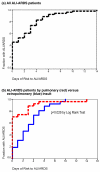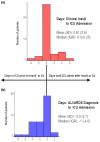Clinical risk conditions for acute lung injury in the intensive care unit and hospital ward: a prospective observational study
- PMID: 17784960
- PMCID: PMC2556739
- DOI: 10.1186/cc6113
Clinical risk conditions for acute lung injury in the intensive care unit and hospital ward: a prospective observational study
Abstract
Background: Little is known about the development of acute lung injury outside the intensive care unit. We set out to document the following: the association between predefined clinical conditions and the development of acute lung injury by using the American-European consensus definition; the frequency of lung injury development outside the intensive care unit; and the temporal relationship between antecedent clinical risk conditions, intensive care admission, and diagnosis of lung injury.
Methods: We conducted a 4-month prospective observational study in three Spanish teaching hospitals, enrolling consecutive patients who developed clinical conditions previously linked to lung injury, both inside and outside the intensive care unit. Patients were followed prospectively for outcomes, including the diagnosis of acute lung injury or acute respiratory distress syndrome.
Results: A total 815 patients were identified with at least one clinical insult; the most common were sepsis, pneumonia, and pancreatitis. Pulmonary risk conditions were observed in 30% of cases. Fifty-three patients (6.5%) developed acute lung injury; 33 of these (4.0%) met criteria for acute respiratory distress syndrome. Lung injury occurred most commonly in the setting of sepsis (46/53; 86.7%), but shock (21/59; 36%) and pneumonia (20/211; 9.5%) portended the highest proportional risk; this risk was higher in patients with increasing numbers of clinical risk conditions (2.2%, 14%, and 21% (P < 0.001) in patients with one, two, and three conditions, respectively). Median days (interquartile range) from risk condition to diagnosis of lung injury was shorter with pulmonary (0 (0 to 2)) versus extrapulmonary (3 (1 to 5)) (P = 0.029) risk conditions. Admission to the intensive care unit was provided to 9/20 (45%) patients with acute lung injury and to 29/33 (88%) of those with acute respiratory distress syndrome. Lung injury patients had higher mortality than others (acute lung injury 25.0%; acute respiratory distress syndrome 45.5%; others 10.3%; P < 0.001).
Conclusion: The time course from clinical insult to diagnosis of lung injury was rapid, but may be longer for extrapulmonary cases. Some patients with lung injury receive care and die outside the intensive care unit; this observation needs further study.
Figures




Comment in
-
Acute lung injury outside the ICU: a significant problem.Crit Care. 2007;11(5):169. doi: 10.1186/cc6128. Crit Care. 2007. PMID: 18001493 Free PMC article.
References
-
- Lesur O, Berthiaume Y, Blaise G, Damas P, Deland E, Guimond JG, Michel RP. Acute respiratory distress syndrome: 30 years later. Can Resp J. 1999;6:71–86. - PubMed
-
- Bernard GR, Artigas A, Brigham KL, Carlet J, Falke K, Hudson L, Lamy , LeGall JR, Morris A, Spragg R. Report of the American-European consensus conference on ARDS: definitions, mechanisms, relevant outcomes and clinical trial coordination. The Consensus Committee. Intensive Care Med. 1994;20:225–232. doi: 10.1007/BF01704707. - DOI - PubMed
-
- Goodman LR, Fumagalli R, Tagliabue P, Tagliabue M, Ferrario M, Gattinoni L, Pesenti A. Adult respiratory distress syndrome due to pulmonary and extrapulmonary causes: CT, clinical, and functional correlations. Radiology. 1999;213:545–552. - PubMed
Publication types
MeSH terms
LinkOut - more resources
Full Text Sources
Miscellaneous

